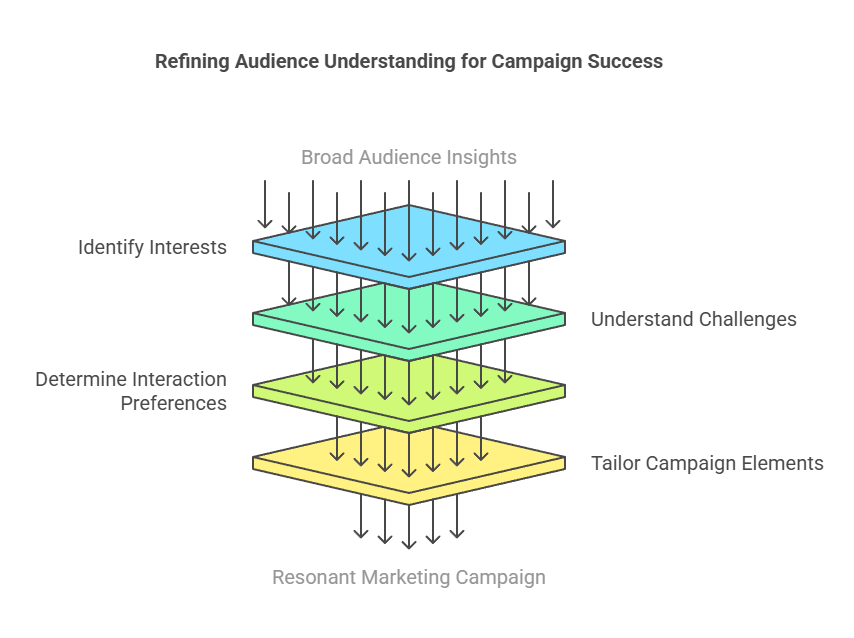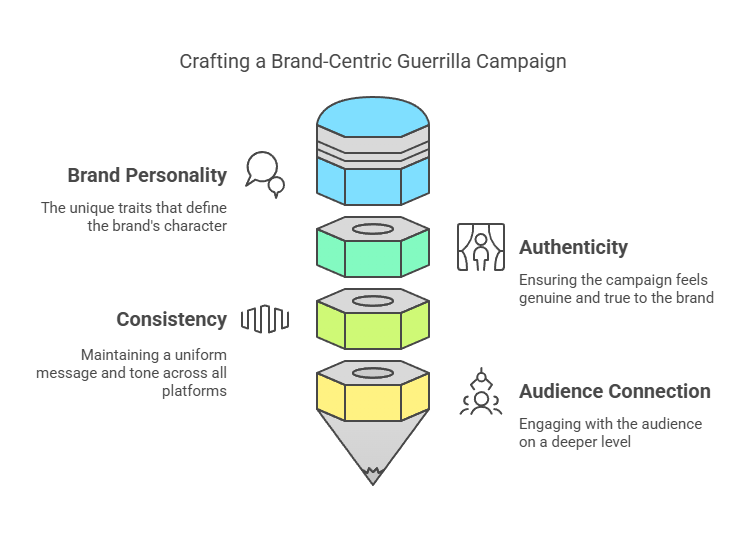Guerrilla marketing is all about standing out. Unlike traditional marketing, guerrilla marketing is unconventional, bold, and creative. It aims to create memorable experiences that grab people’s attention without needing huge budgets. This type of marketing relies on smart, unexpected tactics that make people stop, look, and, most importantly, remember. In this article, we’ll explore strategic guerrilla marketing ideas to fuel creative promotions. We’ll look at the steps behind building an effective guerrilla marketing campaign, ways to measure success, and tips for avoiding common challenges. For brands and businesses aiming to leave a memorable impact on their audience, guerrilla marketing offers a fresh and exciting path.
The Strategic Foundation of Guerrilla Marketing
Before diving into the tactics of guerrilla marketing, it’s important to understand the strategic foundation that makes these campaigns successful. Unlike traditional advertising, where you may rely on broad exposure or repetitive messaging, guerrilla marketing depends on getting the right message in front of the right people in the right way.
Understanding Your Target Audience
The first step in any successful marketing campaign is understanding who you’re trying to reach. For guerrilla marketing, this understanding goes even deeper because your approach needs to speak directly to them. You should know what interests and excites your audience, what challenges they face, and how they like to interact with brands. If your audience loves social media, then making your campaign visually appealing or highly shareable can add to its success. If they are environmentally conscious, then using sustainable materials or crafting a campaign around eco-friendly themes can work in your favor. Knowing these details helps in creating a campaign that resonates with your audience.

Setting Clear Goals
It’s essential to set specific, achievable goals before launching any guerrilla marketing campaign. The goals should align with your brand’s overall objectives and be measurable, so you can assess whether the campaign was successful. Goals might include increasing brand awareness, boosting social media engagement, or even driving a certain amount of sales. By setting clear goals, you give your campaign a sense of purpose and direction. This way, every aspect of the campaign, from design to distribution, works towards achieving these outcomes.
Establishing Brand Tone and Message
The tone and message of your guerrilla marketing campaign should reflect your brand’s personality. Is your brand quirky and playful, or serious and sophisticated? A guerrilla campaign gives you an opportunity to show off your brand’s personality in ways that traditional marketing may not allow. By staying true to the brand’s tone, you create a campaign that feels authentic and connects with people on a deeper level. Consistency in message and tone also helps reinforce your brand identity, making it easier for people to remember and recognize you.

Budgeting Wisely
Guerrilla marketing is known for being cost-effective, but even the most affordable ideas need some budget planning. Identify the resources you’ll need, including any materials, locations, and potential permits if you’re using public spaces. Keep in mind that guerrilla campaigns often rely more on creativity than cost, so focus on ideas that maximize impact with minimal expense. Instead of large advertising buys, consider using things like street art, pop-up installations, or partnerships to help cut costs and stretch your budget further.
Essential Elements of a Successful Guerrilla Marketing Campaign
Once you have your strategy in place, it’s time to look at the elements that make guerrilla marketing campaigns successful. From creativity to engagement, each of these elements contributes to the power of a well-executed campaign.
Creativity and Originality
Creativity is at the heart of guerrilla marketing. Your campaign should be unique and memorable, making people stop and pay attention. Whether it’s a surprising visual, an interactive element, or a humorous twist, originality draws people in and leaves a lasting impression. For example, a coffee company might set up giant coffee cup props that emit steam, giving the impression of freshly brewed coffee. Originality doesn’t just make the campaign memorable; it also helps distinguish your brand from competitors.
Visibility and Memorability
Visibility is crucial for guerrilla marketing, as it determines how many people see your campaign. Choose locations that are high-traffic and relevant to your target audience. Memorability is just as important. Using shock value, humor, or an intriguing message can create an experience that sticks with people long after they’ve encountered your campaign. A clothing brand, for example, might create mannequins dressed in their latest collection and place them in unexpected locations around a city, making passersby stop and look. The more memorable the campaign, the more likely people are to share it with others.
Engagement and Interactivity
Guerrilla marketing campaigns often involve the audience directly, encouraging them to interact or participate. This engagement creates a personal connection, which can lead to better recall and brand loyalty. For example, a makeup brand might set up a pop-up makeup station where people can try on products and take selfies. Interactive campaigns invite the audience to be part of the experience, rather than just passive observers, increasing the likelihood that they’ll remember and talk about it.
Innovative Guerrilla Marketing Tactics
Now that we’ve covered the basics of strategy and essential elements, let’s dive into some creative guerrilla marketing tactics. These tactics offer inspiration for building memorable campaigns that stand out from typical advertisements.
Street Art and Installations
Street art and installations are effective ways to make an impact in public spaces. By using murals, graffiti, or sidewalk art, brands can reach a broad audience and create lasting visual impressions. For example, a fitness brand might create a 3D mural of a track leading up the side of a building, giving people the illusion that they’re running up the wall. This type of installation is eye-catching and invites people to take photos and share them on social media, further extending the campaign’s reach. Street art is also cost-effective compared to traditional media buys, making it accessible even for smaller brands.
Flash Mobs and Live Performances
Flash mobs are a fun and surprising way to catch people’s attention. By organizing a group of performers to act out a skit or dance routine in a public space, you can create a buzz and grab attention instantly. These performances can also go viral if recorded and shared online. For example, a travel company might organize a flash mob at an airport, featuring dancers dressed as tourists from around the world, to promote their brand and encourage people to travel. Flash mobs are unexpected, which adds an element of surprise and excitement that makes people pay attention.
Pop-Up Experiences
Pop-up experiences are temporary installations or events that create a sense of exclusivity. Because they’re only available for a short time, they encourage people to visit before they disappear. For instance, a tech company might set up a pop-up experience that lets people try out its latest devices in an immersive, futuristic setting. Pop-ups allow brands to create unique experiences, helping them connect with their audience in a meaningful way. By focusing on creating memorable interactions, brands can drive engagement and boost awareness.
Public Stunts
Public stunts are bold and often daring actions taken in public spaces to draw attention. These stunts are usually surprising and designed to make a statement. For example, a shoe brand could create a giant shoe sculpture in a park, catching the eye of passersby and drawing attention to their new product line. Public stunts don’t just get people to look; they also encourage word-of-mouth and social media sharing, as people are likely to tell others about what they’ve seen.
Unexpected Collaborations
Collaborating with another brand or organization that people wouldn’t expect can make your campaign stand out. For instance, a coffee company could collaborate with a bookstore to create cozy pop-up reading nooks in public places. This unexpected partnership can surprise people and generate interest, as the campaign brings together two different audiences in a creative way. Collaborations expand your reach and make your campaign more memorable, as people are more likely to remember campaigns that break the mold.
Leveraging Digital Channels to Amplify Guerrilla Efforts
Digital channels are a great way to amplify your guerrilla marketing efforts and extend your campaign’s reach. Social media, user-generated content, and influencers can help bring your campaign to a wider audience, making it more successful and memorable.
Social Media Integration
Integrating social media with guerrilla marketing campaigns is crucial. Encourage people to take photos or videos and share them online with a unique hashtag. For instance, a brand that sets up an eye-catching street art mural could place signs nearby, prompting people to take a photo and post it using a specific hashtag. Social media allows people to share their experiences instantly, spreading the word to people who weren’t even present for the original event.
User-Generated Content (UGC)
User-generated content (UGC) can help create buzz around your campaign. Encourage people to participate by creating something of their own related to your campaign. A food brand, for example, might set up an interactive installation where people can pose with a giant food prop and share their photos on social media. UGC adds credibility to the campaign, as people trust content created by other users more than branded content. It also helps build community, as participants feel like they’re part of the brand’s story.
Influencer Involvement
Influencers can amplify guerrilla marketing campaigns by sharing their experiences with their followers. A fashion brand might invite popular influencers to a pop-up event, where they can try on new products and share their experience online. This approach broadens your campaign’s reach and makes it more relatable, as followers see people they trust engaging with the brand.
Measuring Success in Guerrilla Marketing
To understand the impact of a guerrilla marketing campaign, you need to measure its success. The following metrics can help you gauge how well your campaign performed and determine whether it achieved its goals.
Tracking Engagement and Reach
Engagement and reach are essential metrics in guerrilla marketing. Engagement includes actions like likes, shares, comments, and interactions, while reach refers to the number of people who saw or heard about the campaign. Social media analytics tools can help you track these metrics, showing you how widely your campaign spread and how people reacted to it.
Evaluating Brand Awareness Impact
To measure brand awareness, monitor how often your brand is mentioned online, as well as any increase in followers, likes, or shares. Surveys and polls can also help determine how well people remember your campaign. If your brand sees an increase in recognition or positive sentiment, this may indicate that your campaign successfully boosted brand awareness.
Monitoring Sales or Conversion Uplift
For campaigns aimed at driving sales, track any increase in sales or conversions during or after the campaign. Tools like Google Analytics can help you track online conversions, while in-store sales reports can show physical sales impact. If there is a noticeable uptick in purchases, this may suggest that your guerrilla marketing campaign encouraged people to buy your product or service.
Potential Challenges and How to Overcome Them
Guerrilla marketing is effective, but it does come with risks. Knowing the potential challenges and preparing for them can help ensure your campaign runs smoothly.
Legal and Regulatory Concerns
Guerrilla marketing campaigns often use public spaces, so it’s important to follow local laws and regulations. Get permits if necessary, and avoid campaigns that could be seen as vandalism. Always research local guidelines to prevent fines or backlash.
Risk of Negative Public Reaction
Guerrilla campaigns can sometimes backfire if people find them offensive or disruptive. To avoid this, consider the potential impact of your campaign on different audience groups, and test your ideas with focus groups if possible.
Ensuring Brand-Appropriate Execution
Not every guerrilla marketing idea will suit every brand. Choose ideas that fit your brand’s identity and avoid campaigns that could be seen as inconsistent with your image. A bank, for instance, might not benefit from a highly humorous campaign if its brand is usually serious and trustworthy.
Conclusion
Guerrilla marketing offers brands an exciting way to connect with their audience and leave a lasting impression. By focusing on strategic planning, creativity, and audience engagement, guerrilla marketing campaigns can generate buzz and boost brand awareness in ways traditional advertising may not. Whether through street art, pop-ups, or social media integration, the possibilities for guerrilla marketing are endless. Embrace creativity, think outside the box, and let your brand’s personality shine through.
